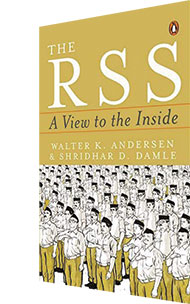The RSS: A view to the inside,Walter K. Andersen & Shridhar D. Damle, Penguin Viking; Rs.699, Pages 405
 When Walter Andersen and Shridhar Damle published their first book on the Rashtriya Swayamsevak Sangh, The Brotherhood in Saffron: The RSS and Hindu Revivalism, in 1987, it was welcomed in India and abroad. After all, there was not much scholarly study of this Hindu nationalist organisation those days. Since then, the RSS has grown enormously in terms of operational footprint, political and social influence and visibility. Quite rightly, in their new book The RSS: A View to the Inside, Andersen and Damle make the claim that “to understand India requires an understanding of the RSS”. The claim is tall, but incontrovertible.
When Walter Andersen and Shridhar Damle published their first book on the Rashtriya Swayamsevak Sangh, The Brotherhood in Saffron: The RSS and Hindu Revivalism, in 1987, it was welcomed in India and abroad. After all, there was not much scholarly study of this Hindu nationalist organisation those days. Since then, the RSS has grown enormously in terms of operational footprint, political and social influence and visibility. Quite rightly, in their new book The RSS: A View to the Inside, Andersen and Damle make the claim that “to understand India requires an understanding of the RSS”. The claim is tall, but incontrovertible.
This is because the RSS is no longer the political pariah it used to be right until the early 1990s. Through its several affiliates that constitute the sangh parivar (‘RSS family’), it has penetrated “almost all areas of society”, and therefore receives regular feedback on the majority Hindu community’s problems and aspirations and how government policies are impacting it.
The authors describe how policy debate and even an active role in policy formulation (including in the crucial area of education, which has been accorded a separate chapter) have become important new activities of the RSS family. Most important, the BJP, an offspring of the RSS, has been voted to power at the Centre twice and has also succeeded in forming governments in several states. Naturally, and much to the chagrin of its opponents, the RSS is taking an “increasing interest in influencing government decision-making”.
This book sheds useful light on the phenomenal expansion in the activities of the RSS since the 1980s. No other social, cultural or political organisation comes anywhere close to matching its involvement, through its 36 affiliates, in the most diverse domains of national life — from politics (BJP) to education (Akhil Bharatiya Vidyarthi Parishad, the largest students organisation in India); from labour (Bharatiya Majdoor Sangh, the largest trade union in India) to farmers (Bharatiya Kisan Sangh); from Hindu solidarity (through the Vishwa Hindu Parishad) to tribal mobilisation (Vanavasi Kalyan Ashram).
These organisations are largely autonomous, run by pracharaks of the RSS, with the parent body mainly discharging the role of coordination and problem-solving. Unlike K.B. Hedgewar, its founder and chief (1925-1940), or its second sarsanghchalak M.S. Golwalkar (1940-1973), its incumbent chief Mohan Bhagwat is not a supremo who towers over the organisation; he works in close and regular consultation with his senior colleagues and heads of affiliated organisations. Indeed most critics of the RSS don’t know or care to know, is how democratic is the internal functioning of the sangh parivar. They also tend to overlook the sangh parivar’s growing reformist campaign against caste inequality and discrimination.
Where the authors fail badly is in probing the inconsistencies and inherent untenability of the RSS’ central ideological tenets — India as a Hindu rashtra (nation) and Indian nationalism as hindutva. According to Bhagwat, “All Indians are culturally Hindu.” For too long, the RSS has indulged in such verbal jugglery propagating that ‘Hindu’ is a cultural rather than a religious descriptive. This does not convince even the meanest intelligence because most of the activities of the RSS and its affiliates — Vishwa Hindu Parishad and Bajrang Dal — are conducted in the name of Hindus as religious Hindus, who are separate and distinct from Muslims and Christians.
In his Bunch of Thoughts (1966), Golwalkar identified “Muslims and Christians as internal threats to national unity”. Having noted this, the authors nevertheless assert that “its (RSS’) senior leadership has broadened the definition of Hindu to include most Christians and Muslims”. The plain truth is that championing Hindu rashtra and hindutva is a blatant project to ‘Hinduise non-Hindus’, which violates the constitutional imperative of a secular state. The RSS’ much proclaimed outreach to Muslims through its Rashtriya Muslim Manch (MRM), is coloured and constrained by this attitude. No wonder, most Muslims are deeply apprehensive of, and strongly oppose the RSS.
Moreover, A View to the Inside doesn’t probe the RSS’ proclaimed panacea for the long-standing Kashmir problem. The solution it proposes — “Get Pak-occupied Kashmir back” — is bankrupt. Neither do the authors have anything constructive to say about a China-India rapprochement. All in all, the book is long on information but short on critical, insightful analysis.
Sudheendra Kulkarni


























